Crude oil prices surged last spring following disruptions in oil production from Libya, and had been drifting down during the summer and fall. But since the beginning of October, the price of West Texas Intermediate and Brent crude oil have both risen by over 30%, putting them back up near where they had been last spring. What’s changed in the world since the beginning of October?
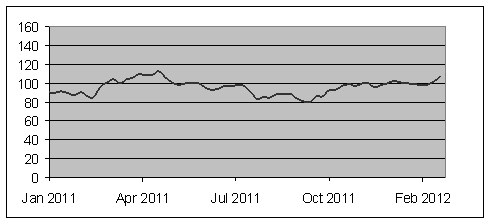 |
Although conditions in Libya may have stabilized, the possibility of military conflict in Iran has been increasingly discussed, an event which would be hugely important for oil markets. Here for example is a measure of the volume of Google searches for “Iran War”.
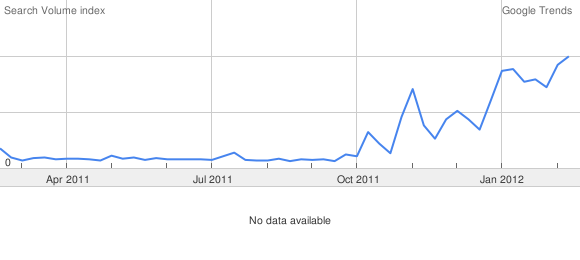 |
The Wall Street Journal suggested that U.S. monetary policy could also be a factor in recent price movements:
Oil staged its last price surge along with other commodity prices when the Fed revved up its second burst of “quantitative easing” in 2010-2011. Prices stabilized when QE2 ended. But in recent months the Fed has again signaled its commitment to near-zero interest rates first through 2013, and recently through 2014. Commodity prices, including oil, have since begun another surge, and hedge funds have begun to bet on commodity plays again. John Paulson says he’s betting on gold, the ultimate hedge against a falling dollar.
Below I’ve graphed the price of oil along with 9 other commodities that I could find quickly on Webstract. Oil increased 22% in the last 3 months of 2011; the next biggest gainer over this period was copper, which was up less than 4%, and most were actually down over those 3 months. Since the start of this year, the metals have climbed, though their gain is still typically less than half that of oil. Most agricultural commodities are still below their levels of the start of October.
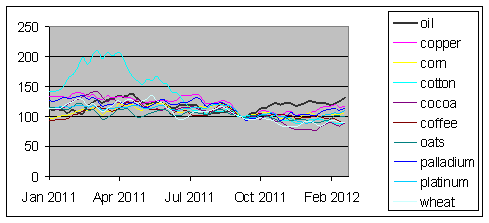 |
Here are some other metals prices from Kitco, again showing gains since October, but significantly less than those for oil.
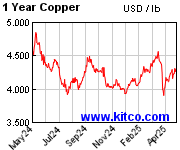
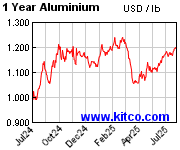
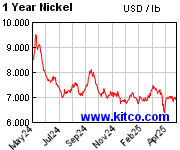
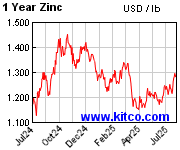
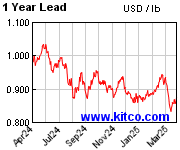
Are there factors other than U.S. monetary policy that could have contributed to a modest increase in broader commodity prices since the start of the year? U.S. economic conditions have been improving, and worries about a financial crisis emanating from European sovereign debt problems seem to be weighing less on financial markets. An improving outlook for real economic activity (particularly in Asia, which has been driving global commodity demand) could have made a modest contribution to the price of oil and some other commodities over the last few months.
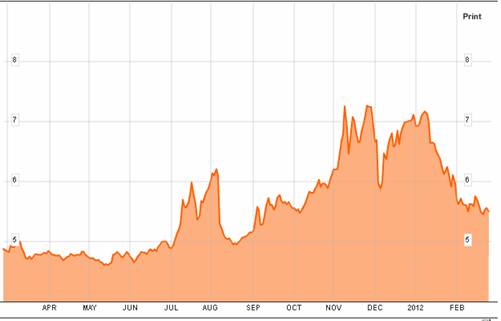 |
 |
In general, I agree that the Fed needs to keep a watchful eye on commodity prices as one potential indicator that their efforts to stimulate the U.S. economy are having undesirable side effects. But based on the evidence so far, I think the Wall Street Journal is crying wolf a little too early.
In 2004, Daniel Yergin assured us that crude oil prices would soon be back down to $38 per barrel, as increasing oil production drove down prices. In a similar fashion, Michael C. Lynch has insisted for years that oil prices would soon be down in the $40 range, for similar reasons.
Based on Yergin & Lynch, et al’s, pronouncements, one would have reasonably concluded that there was no problem with the US auto centric, suburban way of life, and there would be no problem with consuming like there is no tomorrow.
But tomorrow did come.
The reality is that since 2005 we have seen virtually no increase in global crude oil production and total petroleum liquids. We have seen a slight increase (up 0.5%/year from 2005 to 2010) in total liquids production, inclusive of low net energy biofuels, but we have seen a material and ongoing decline in Global Net Exports of oil (GNE) and in Available Net Exports (ANE). ANE are defined as GNE less Chindia’s combined net oil imports.
The annual price of Brent crude oil doubled from $55 in 2005 to $111 in 2011. Excluding WTI, global spot crude oil prices currently range from $121 to $137.
My advice from five years ago was to ELP, for Economize; Localize and Produce:
http://www.energybulletin.net/stories/2011-08-08/elp-plan-economize-localize-produce
Excerpt:
“Author Thom Hartmann, in his book, “The Last Hours of Ancient Sunlight,” described a high tech company that he consulted for that went through several rounds of start up financing, and then collapsed, without ever delivering a real product. At the peak of their activity, they had several employees and lavish office space–until they ran out of capital. His point was that this company was analogous to a large portion of the US economy, which has the appearance of considerable activity and uses vast amounts of energy, but how much of this economic activity delivers essential goods and services?
“I have read, and it seems reasonable, that the majority of Americans live off the discretionary income of other Americans. We are therefore facing a wrenching transformation of the US economy–from an economy focused on meeting “wants” to an economy focused on meeting needs–and the jobs of a vast number of Americans are thereby directly threatened in a post-Peak Oil environment.”
Readers can judge for themselves who has provided the best advice–the Cornucopians or the Crazy Peak Oilers.
If–and it’s a huge if–but if we extrapolate recent trends, the total post-2005 cumulative supply of net oil exports that is available to importers other than China and India will be about half depleted by the end of next year.
Consider the time period between the Titanic hitting the iceberg and actually sinking. In the first 15 minutes, only a handful of people knew that ship would sink, but that did not mean that the ship was not sinking. In the last 15 minutes, it was readily apparent to everyone that the ship was sinking, but by then it was far too late to try to get to a lifeboat.
Very interesting reference to the Google Trends data on “Iran War”. Does the volume of other related search terms have the same correlation with oil prices?
Thank you. But couldn’t you also have said that oil prices haven’t risen much? With the absurd news cycle, every little tick becomes a harbinger of crisis. The graphs of the individual commodity prices show a high a year ago when the same voices were worrying about inflation surging – and then they dropped and are still below those highs.
I’ve got a good chunk of my retirement in the Pimco commodity fund, which has a big oil weighting. I guess that makes me one of those evil speculators Nancy Pelosi keeps whining about.
I’m going keep investing in commodities until I see signs of responsible fiscal and monetary policy. And I don’t expect to see that for a long, long time.
Is it the possibility of an Israeli strike against Iran prompting the closing of the Straits of Hormuz that’s driving up oil prices? Or is it the expected embargo of Iranian oil come this summer? Wall St. types are certainly competent to make judgments about the latter, but they are probably out of their depth when it comes to the former.
I don’t quite follow this argument I’ve been hearing about the Fed causing higher oil prices. In order for that to be true, wouldn’t the markets have to expect a fall in the value of the dollar? And doesn’t that imply inflation? If the oil markets expect inflation, then why don’t the bond markets? If the currency markets are skittish about the strength of the euro, then why would they also worry about a weak dollar?
Lots of chickens. Lots of eggs.
“An improving outlook for real economic activity (particularly in Asia, which has been driving global commodity demand) could have made a modest contribution to the price of oil and some other commodities over the last few months.”
Aside from production disruptions (or fear of them), global economic activity has to be the key driver of oil price changes. A very small change in outlook for the next five years would justify a significant change in current oil prices. I think this deserves more scrutiny. (And you’re a better guy to scrutinize it than me.)
The short list of reasons:
1. Geopolitical tensions (looming Western sanctions on Iranian oil) causing rising prices for Brent crude.
2. Falling demand in the U.S.
The combination is pushing the closure of money-losing refineries in the U.S., which has caused a relative reduction in the quantity supplied – particularly on the East coast.
More will be explained in detail at the link below, which I’m afraid won’t become active until the morning of 27 February 2012:
Questions From Our Inbox: Why Are Gasoline Prices Rising So Much?
Let’s presume that Obama’s anti-drilling policy which has led to an 11% decline in oil exploration on federal lands and the slow-crawl permitting of offshore drilling has had nothing to do with oil prices increasing globally. Furthermore let’s presume that the Keystone pipeline will have no effect in the future with regard to oil prices.
Let’s only presume that prices are impacted when non-North American oil supplies are threatened or there is the threat of a threat.
Then markets wisely react to possible supply reductions as opposed to ongoing domestic and North American supply restrictions. Which further makes the case for reducing North American oil production because such production is irrelevant to oil prices and can only cause all of the ground water in North America to be contaminated.
Besides, all cars and light trucks will soon average 54 mpg as required by the Obama administration, so there will be little need for oil… especially North American and specifically U.S. oil.
Is that about right?
Why does the USA threaren their own economy by
shutting down Iran’s oil exports?
Speculators hold 70% of the open interest in oil futures. If the CFTC actually enforced it’s rules speculators would only be allowed to hold 30% and the price of oil would reflect supply and demand. The world is awash in oil, the rise in prices is just more manipulated greed by Goldman and the rest of the usual suspects.
Bruce, are those “North American supply restrictions” and “anti-drilling” policies the same ones that have created three consecutive years of rising (not falling) domestic crude production (source: http://www.eia.gov/dnav/pet/hist/LeafHandler.ashx?n=pet&s=mcrfpus1&f=a)? Or that have sent oil rig counts to more than 2.5x their previous 10Y high (source: http://investor.shareholder.com/bhi/rig_counts/rc_index.cfm)
On the supply side, North American production is one of the few bright spots globally.
This time is different
Apparently there is more linearity in the “sciences” of politics than in the prices and volume traded in oil.
On volume and prices Nymex, is exhibiting a large increase in volume traded in the oil futures,prices are as well showing an inflexion point as of February 2012.
Please see http://www.cmegroup.com/trading/energy/crude-oil/light-sweet-crude.html
Then press April 2012 and add volume to the chart
On politics as a sciences of linearity,Paul Kennedy “Rise and falls of the great powers” has expanded at large on the gun boats diplomacy.
During the Irak,Iran war 1980 1988 the straight of Ormuz has never been under threat of closure,but tankers from Iran were the first casualties when under shelling from Irak.The straight of Ormuz has never been closed but the tankers of both countries were damaged.
GeorgeK:
“The world is awash in oil, the rise in prices is just more manipulated greed by Goldman and the rest of the usual suspects.”
It’s always helpful to look at what the actual data show.
Five annual “Gap” charts follow, showing the gaps between where we would have been at the 2002 to 2005 rates of increase, versus the actual data in 2010 (common vertical scale):
EIA Total Liquids (including biofuels):
http://i1095.photobucket.com/albums/i475/westexas/Slide1-18.jpg
BP Total Petroleum Liquids:
http://i1095.photobucket.com/albums/i475/westexas/Slide06.jpg
EIA Crude + Condensate:
http://i1095.photobucket.com/albums/i475/westexas/Slide05.jpg
Global Net Oil Exports (GNE, BP & Minor EIA data, Total Petroleum Liquids):
http://i1095.photobucket.com/albums/i475/westexas/Slide07.jpg
Available Net Exports (GNE less Chindia’s net imports):
http://i1095.photobucket.com/albums/i475/westexas/Slide08.jpg
I would particularly note the difference between the first chart, total liquids, and the second chart, ANE.
I estimate that there are about 157 net oil importing countries in the world. If we extrapolate the Chindia region’s rate of increase in their combined net oil imports, as a percentage of GNE in 19 years just two of these oil importing countries–China & India–would consume 100% of GNE.
US annual crude oil production did rise from the pre-hurricane level of 5.4 mbpd in 2004 to 5.65 mbpd in 2011 (through November), versus the 1970 peak rate of 9.6 mbpd. This is helpful, but the former CEO of Shell Oil described it as a “trickle” of higher production, and we remain dependent on imports for about two out of every three barrels of crude oil that are processed in US refineries.
We do have of course have production from thermally mature shale formations, like the Bakken and Eagle Ford, but there is no commercial production from the “shale” deposits in Colorado, which is really a kerogen rich marl deposit that has to be “cooked” in order to produce a liquid that can be refined. In any case, I suspect that the net energy to be derived from these kerogen deposits is, at best, minimal.
And of course, Canada has shown increasing net oil exports, which are calculated in terms of total petroleum liquids, but the combined net oil exports from the seven major net oil exporters* in the Americas and the Caribbean fell from 6.2 mbpd in 2004 to 4.8 mbpd in 2010, a 23% decline in six years.
The dominant trend we are seeing is that the US, and most other developed oil importing OECD countries, are being gradually priced out of the global market for exported oil, as annual global (Brent) crude oil prices doubled from 2005 to 2011.
*Canada, Mexico, Venezuela, Colombia, Argentina, Ecuador, Trinidad & Tobago
Professor,
Thank you for the thoughtful post. The fact that you simply do not write off the connection to the increase in the price of oil and the debasement of the dollar shows an open mind. Of course there are many factors that influence the price of oil, but, as the WSJ points out, monetary policy is one of the most significant.
Based on the relationship between a bbl of oil and an oz of gold oil is still underpriced. If the Journal is right we could have a huge rise in the price of energy this summer, and it appears that most commentary right now is sensing the same thing.
Bernanke is caught between debasing the currency to write off the national debt on the backs of currency holders and creating an inflationary economic decline. Most are betting that as with past FED chairmen inflation will be in second place behind facilitating the national debt.
Mitch,
“The increase in domestic drilling was almost entirely in areas for which the Obama administration exercised no authority, as oil production on federal land declined by 11 percent in fiscal year 2011, according to a study by the Institute on Energy Research (IER), a free-market energy think tank. But oil production on state lands increased that year by 14 percent and increased by 12 percent on private lands.”
http://cnsnews.com/news/article/obama-s-claim-increasing-domestic-drilling-not-accurate-say-energy-analysts
In other words, if Obama’s policies had not been anti-drilling and restrictive… and production on federal lands had simply remained the same… there would have been a greater increase in supply of crude.
In his own words:
http://fora.tv/2008/07/15/Directors_Forum_with_Senator_Barack_Obama#fullprogram
How has that worked out?
Gasoline and oil are showing a lot of price inelasticity. It looks like the last gas spike (and coincidental unemployment) destroyed considerable price elastic marginal demand. US demand for gasoline is only down about 5% on a yr/yr basis despite the price difference. If that is the case it is possible that energy costs will be able to rise to 6% of hh income without the usual cut to consumption. It is interesting to watch the Brazilians import corn ethanol as the demand for sugar crowds out sugar ethanol production.
How is inflation in the rest of the world? Does it correlated with monetary policy here?
aaron,
Most currencies in the world are linked to the dollar in some way so yes, US monetary policy is transferred to the rest of the world. There are many transmission mechanisms. Consider that the Chinese have virtually pegged the yuan to the dollar. That means that if the dollar declines so will the yuan. China has been fighting inflation for a number of years attempting to use the mainstream techniques but they have not been very effective.
One question that is always asked is why there is no inflation in the US? Acutally there is inflation in the US. Statistics elminiate critical commodities from the inflation statistics such as foold and energy.
But additionally, the FED and the congress have concentrated inflation in specific commodities so that rather than general price rises today we see “bubbles” that grow then burst, depending on where congress directs the flow. This is easily seen in the housing problems bubble, the health care bubble, the education bubble, and the welfare bubble. All of these areas have had massive increases in cost and spending.
The monetary policy of the US and the monetary policies of other countries are intimately related but the fiscal policies of each country may change the distribution of the impact to different segments of their economies.
Often economists do their analysis at the macro level and miss the heart of the issue at the micro level. It is hard to see the snakes without digging into the weeds.
Are you going to post on the new Keystone plans, particularly on the piece from Cushing south?
What Jeffery J. Brown said.
http://en.wikipedia.org/wiki/Price_of_petroleum
http://www.indexmundi.com/commodities/?commodity=crude-oil&months=120
http://www.nytimes.com/2008/03/04/business/worldbusiness/04oil.html
oil price inflation adjusted
http://www.worldoils.com/oilprice.php
http://inflationdata.com/inflation/inflation_Rate/Historical_Oil_Prices_Table.asp
I know economists are indoctrinated to think the FED causes all good and bad, and I know they are indoctrinated to believe that there are substitutes for any commodity, but oil is unique.
It has only been 100 years that the world has been as dependent on oil as it has been, but oil is the basis for so much of the worldn’t productivity (hard to ship products from China without, or produced abundent food either).
As oil price rises in real terms, the changes will be wrenching.
Art: “Speculators hold 70% of the open interest in oil futures. […] The world is awash in oil, the rise in prices is just more manipulated greed by Goldman and the rest of the usual suspects. ”
That’s 70% of 1.5 million contracts open interest on the NYMEX front contract. A contract is for 1,000 barrels, so it’s a billion barrels or so.
Global demand is forecast to be 30 billion barrels this year.
That’s quite the tail wagging the dog.
@Art: Except speculators don’t hold 70pc of the open interest in oil futures, they hold closer to 22pc (managed money category positions for WTI, heating oil and Rbob futures in the CFTC’s Commitment of Traders Report).
If you want to lump swaps dealers (26pc) in with the managed money traders as speculators, you’re ignoring that most of their business is writing swaps for commercial oil firms in the OTC market and laying off that risk on the futures markets.
There’s no real mystery to why oil prices are rising:
* Global stock cover has been falling for a year and a half
* Non-Opec production has been plagued with problems (Sudan, Yemen, North Sea), and the only bright spot — the US shale sector — is mostly confined to the landlocked midcontinent market.
* Non-OECD oil demand is still growing rapidly enough to offset the drop in demand in the US, Europe and Japan.
There is just not enough supply in the market and hasn’t been for six quarters. Supply is not responding to high oil prices, so the price of oil has to be high enough to rein in demand growth in industrialising Asian markets.
Do we really need to ask what’s causing oil prices to rise again? And is it any mystery that oil is rising in virtual lockstep with the S&P 500, and moving inversely to the VIX, Italian and Spanish bond yields, and other market risk measures? This is simply the same “QE effect” we saw with QE1 and QE2, and are now seeing courtesy of LTRO (backdoor European QE), QE-UK (Posen and his cohorts are printing pounds like they’re going out of style!), and even QE-J (BOJ just said it would throw 10 more trillion yen into the pot).
Instead of trying to complicate things, keep it simple. Every single time since 2008 when global central banks have ramped up their money printing efforts, “good assets” like stocks and junk bonds have gone up in value. But so have “bad assets” like commodities. Ben Bernanke and other Fed apologists pretend that one (the bad) has nothing to do with the other (the good). They blame everything from drought in Russia to war in Libya to “evil speculators” for increases in commodities, while simultaneously taking credit for the marvellous increases in the Russell 2000. But those of us who live in the real world know the truth … QE is a disastrous, self-defeating, asset-inflation policy. Every dollar in gains in stocks, junk bonds, and so on that investors make, they lose when they gas up their cars and buy groceries. Then when the pain gets too severe, the economy hits a wall and the whole ridiculous process plays out again. Sad.
Re: Mike in Fl
Of course, there is always the possibility of supply & demand factors at work.
Note that annual Brent crude oil prices doubled from $55 in 2005 to $111 in 2011, and based on the WTI crack spread, here in the US we are effectively paying Brent crude oil prices at the pump.
Following is what BP shows for changes in total petroleum liquids consumption for China, India and the US from 2005 to 2010:
China: +2.2 mbpd
India: +0.7 mbpd
China + India: +2.9 mbpd
US: -1.7 mbpd
Chindia’s combined net oil imports rose from 5.1 mbpd in 2005 to 7.5 mbpd in 2010 (BP). Over this time frame, Global Net Exports of oil (GNE*) fell from 45.5 mbpd to 42.6 mbd.
Therefore, Chindia’s combined net oil imports, as a percentage of GNE, increased from 11.2% in 2005 to 17.6% in 2010.
If, and it is a big if, but if we extrapolate this trend, the Chindia region would consume 100% of GNE in only 19 years.
*Top 33 Net Oil Exporters in 2005, BP + Minor EIA data, total petroleum liquids
Mike_in_Fl: I agree that loose monetary policy is driving higher commodity prices but I disagree that open-market bond purchases (QE) is bad monetary policy.
The problem is that, once again, the radical stimulus is being left in place too long. The FED should have started tightening in late 2009.
Fiscal policy could offset the monetary policy by for example scheduling in significant excise tax increases on gasoline and diesel fuel but voting Americans of all ideological persuasions remain united in their strong preference for cheap energy and do not seem to mind, for example, their reputation as the foremost terrorists or killers of grandchildren and grandparents.
Personally, I would get tired of that reputation for efficient albeit gratuitous throat-slitting of civilians and all the inevitable economic consequences that flow from it. But clearly that is not the way voting Americans see it, except for a few mavericks here and there.